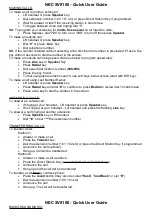
62
Calling ACD Group
:
An incoming call rings simultaneously on all member phones
that are logged in, even if a member is on another call.
For example, if A, B, C, and D are all available, an incoming call will ring
simultaneously at all four extensions until the total timeout value for the group is
reached (see the discussion of timeout values later in this section).
The practical effects of this behavior are as follows:
A Calling Group call alerts an agent's telephone that is busy or on another call
once, then blinks on the WMI LED.
Only one call is served out to the ACD queue. The other calls must wait to be
served or routed to call coverage until after the Total Timeout value has been
reached.
If all Calling Group members are logged out, the system forwards the call to call
coverage immediately.
You cannot configure the system to log out an agent that does not answer
automatically.
MIA ACD Group
: The
system can distribute calls to the group on the basis of idle
time, that is, the system directs the call to the agent who has been idle for the
longest amount of time. If this agent does not answer the call, the system directs the
call to the agent that has been idle for the second longest amount of time. If the
second agent does not answer the call either, the system then treats the call as linear.
For example: if A, B, and C are logged in to the ACD group, then an incoming call is
routed to the member who has been idle for the longest amount of time since its last
ACD call. Say the idle timestamp of A, B, C are t1, t2 and t3 respectively where t1 is
later than t2 and t2 is later than t3 then the call is routed to C. If all members are busy
or logged out, then the call will wait till the total timeout value is reached or any
member comes into the available state. Upon total timeout call is routed to the
specified call coverage point. (see the discussion of timeout values and call
coverage points later in this section)
LCC ACD Group
:
Least Call Count mode distributes calls to ACD agents based on
the number of calls those agents have answered in a defined period of time.
In other words, the agent with the least number of answered calls for a given duration of
time becomes the next available agent. For example, two agents in a group each have
been logged in to their ACD group for ten minutes. Agent One, has answered five
calls and Agent Two has answered ten calls. In this case, the system assigns Agent
One to receive the next incoming call.
All types of ACD group provide a timeout value that defines final call handling, such as
voice mail or Auto Attendant, if the timeout value is exceeded. (see the discussion of
timeout values and call coverage points later in this section)
For each ACD group type, you configure two timeout values:
Device Timeout
: Specifies how long the VCX call processor rings at one extension
before moving to the next extension if there is no answer.
Total Timeout
: Specifies how long the VCX call processor attempts to make a
connection within the group before directing the call to the ACD group’s call coverage
point. You can configure the call coverage point to be:
A voice mailbox
Another ACD group
An individual extension
















































